Outdoor show
Here's a brief look at Phimai Museum. More photos of the exhibits to follow. Well, the ones I could see which are housed in the outdoor exhibition area, which is much like an overflow storage depot. The doors to the indoor exhibition rooms remained closed as it was Monday, and everything is shut on Mondays, even though the staff were in the building, but couldn't be persuaded to open the doors. My silver tongue failed to work on this occasion.
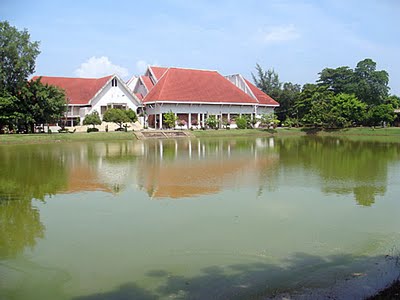 Looking across a small lake to the main exhibition buildings of the museum. The outdoor storage area is on the right, out of shot.
Looking across a small lake to the main exhibition buildings of the museum. The outdoor storage area is on the right, out of shot.
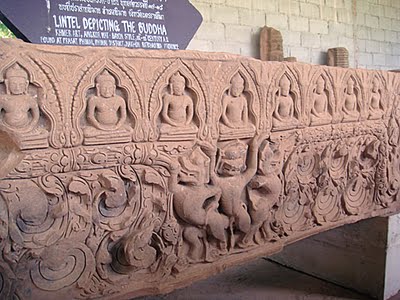 A perfect example of the lintels on display in the outdoor storage facility, most are sign-posted, like this red sandstone lintel depicting Buddhas in meditation
A perfect example of the lintels on display in the outdoor storage facility, most are sign-posted, like this red sandstone lintel depicting Buddhas in meditation
 Looking across a small lake to the main exhibition buildings of the museum. The outdoor storage area is on the right, out of shot.
Looking across a small lake to the main exhibition buildings of the museum. The outdoor storage area is on the right, out of shot. A perfect example of the lintels on display in the outdoor storage facility, most are sign-posted, like this red sandstone lintel depicting Buddhas in meditation
A perfect example of the lintels on display in the outdoor storage facility, most are sign-posted, like this red sandstone lintel depicting Buddhas in meditationLabels: Isaan, Phimai Museum
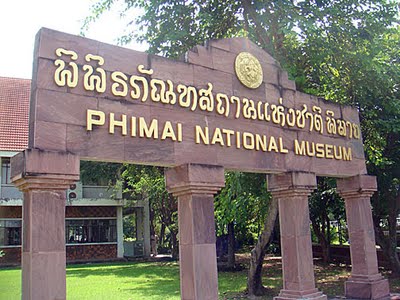
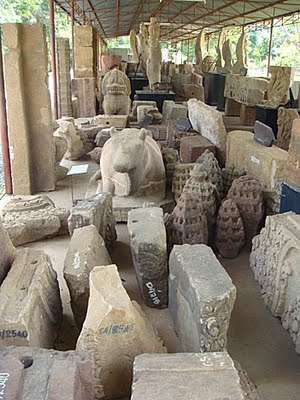
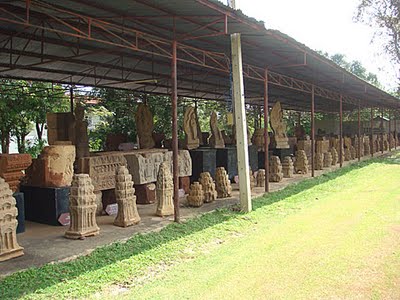


4 Comments:
Hi Andy some artifacts that are displayed outdoor were not all originated from Khmer temples in Thailand During decades of civil war in Cambodia and due to poverty and corruption in Cambodia many of these artifacts ended up in Thailand through looting and smuggling from Cambodia. When I was in a refugee camp in Thailand many Thais paid poor Cambodians to loot their ancient heritage and brought them to Thailand. So, today Thailand has many Khmer artifacts that are not originated in Thailand. It is sad but Truth. The heights of the looting were during the Lonol period and Vietnamese occupation. There was no looting during the Khmer Rouge.
Anon,
It's well documented that Khmer artifacts have been spirited over the border to Thailand for many, many years. The best example of this was at Banteay Chhmar where whole sections of wall carvings were stolen and whisked over the nearby border - some were rescued, others disappeared forever. Thailand has long been a place where Khmer artifacts can be purchased directly or it acts as the middleman for dealers from other countries.
Don't believe the hype that there was no looting during the Khmer Rouge period. I couldn't say that artifacts were sent out of the country by the KR, but Ta Mok for example, looted many ancient temples to add to his own personal collection over the years. Many of those items I saw myself in the Angkor Conservation Depot a couple of years ago.
Andy
Yeah, maybe the big the guys like Ta Mok and others but regular Khmer citizens were not dare. There lives were endangered every breath they took. I know during the Lon Nol period my father stationed at Ordormeanchy province near the Thai border, the military commanders/leaders claimed the temples along the border looted artifacts trucked them to Thailand.
The only way to determine what was here and what has now disappeared, would be to compare each temple site (and museum) THEN and NOW. Pick a date and compare photographs of the temple sites (and museum collections). This would highlight the lintels, pediments, carvings and sculptures that have been spirited away in the intervening period, and which now reside in public museums or private collections around the globe. However its a very difficult task as I'm not aware that each temple site was catalogued in such a way in photographic form, and if they were, whether those photos survived the civil war period. There are thousands of temple sites across the country, so such a photographic catalogue would be enormous.
Even that would only highlight what was now missing, rather than who actually removed the items or where they had gone.
And I've seen for myself that some ancient temples, that were standing a few decades ago, are now literally just piles of rubble on the ground, usually surrounding a large hole. Complete destruction of many temples has become the norm in the remote countryside.
The authorities here have already identified many key individual sculptures that have disappeared and the book, "One Hundred Missing Objects: Looting in Angkor" is part of the ongoing work in trying to obtain the return of these pieces to Cambodia. But its a mammoth task and many museums refuse point blank to return items which are obviously of Khmer origin.
I have a headache just thinking about it.
Andy
Post a Comment
<< Home